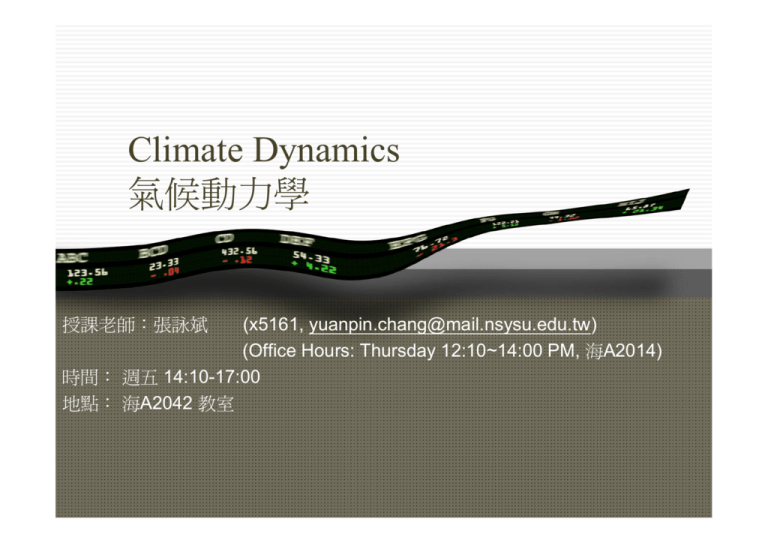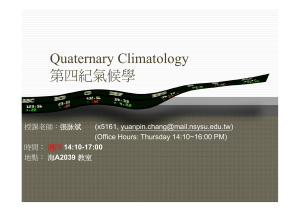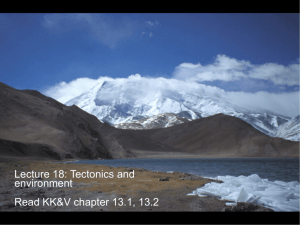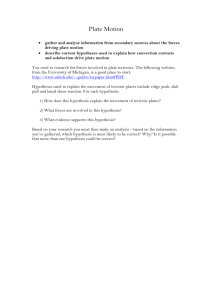Climate Change and CO 2
advertisement

Climate Dynamics 氣候動力學 授課老師:張詠斌 (x5161, yuanpin.chang@mail.nsysu.edu.tw) (Office Hours: Thursday 12:10~14:00 PM, 海A2014) 時間: 週五 14:10-17:00 地點: 海A2042 教室 Schedule • 0917 Introduction of Earth’s Climate (1) • • 0924 Introduction of Earth’s Climate (2) • • 1001 Introduction of Earth’s Climate (3) • • • 1008 Introduction of Earth’s Climate (4) : Monsoon • • 1015 Introduction of Earth’s Climate (5) : Wind and Monsoon • • 1022 Typhoon Holiday • • 1029 Solar Activity and the Stratosphere • • 1102 Climate Archives, Data and Models • 1109 CO2 and Long-term Climate • 1119 Mid-term 1126 Plate Tectonics and Climate (I) (Mid-term Paper Report) 1203 Plate Tectonics and Climate (II) 1210 Orbital-scale climate change (I) 1217 Orbital-scale climate change (II) 1224 Orbital-scale climate change (III) 1231 Deglacial and Millennial Climate Changes (I) 0107 Deglacial and Millennial Climate Changes (II) 0114 Final Exam (3 pages paper report) Episode 9 Plate Tectonics and Climate (I) Tectonic Plates A. Wegener (1914) proposed that continents have slowly moved across Earth’s surface for hundreds and millions of years. Earth’s structure Continental crust: granite, 3070 kilometers thick, 2.7 g/cm3 in density. Ocean crust: basalt, 5-10 kilometers thick, 3.2 g/cm3 in density. Plate margins Divergent (輻散) : mid-ocean ridge Convergent (輻合): trench, subduction Transform fault (轉形斷層) Tectonic Plates Earth’s magnetic field Magnetic stratigraphy 1. To roll back the recent motions of the seafloor. 2. To reconstruct the rate of seafloor spreading. Age of the seafloor The Polar Position Hypothesis 1. Ice sheets should appear on continents when they are located at polar or near-polar latitudes 2. No ice should appear anywhere on Earth if no continents exist anywhere near the poles moraine scrape Roche moutonnee Climate Change and CO2 Data from: Wikipedia Pangaea Pangaea (盤古大陸) Laurasia (勞亞) Gondwana (剛瓦納) Model simulation evaporite (蒸發岩) Temperature and monsoon Tectonics Zachos et al., 2001 Climatic Change for the Past 5 My Tiedemann et al., 1994 BLAG hypothesis (spreading rate hypothesis) Spreading rate and CO2 input Negative feedback Chemical weathering on land: CaSiO3 (Silicate rock) + CO2 (Atmosphere) → CaCO3 (plankton) +SiO2 (plankton) Meting and transformation in subduction zones: CaCO3 + SiO2 (ocean sediments) → CaSiO3 (Silicate rock) + CO2 (Atmosphere) In this hypothesis, chemical weathering is a response driven by three factors: Temperature, precipitation and vegetation. The Uplift Weathering Hypothesis










